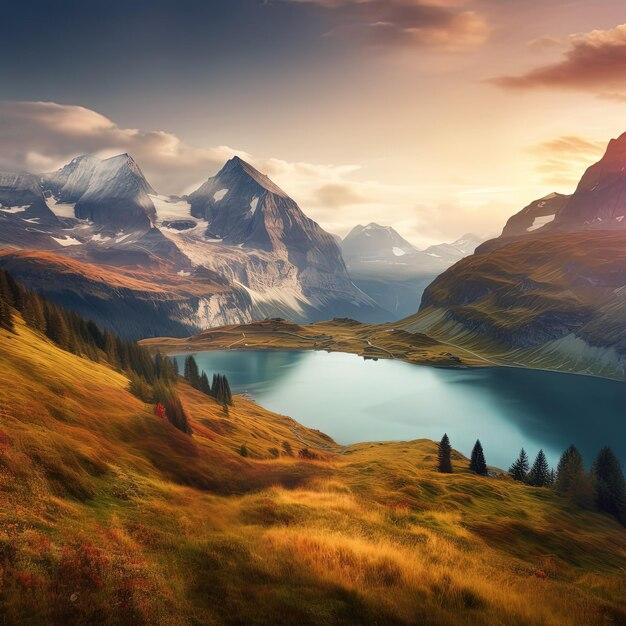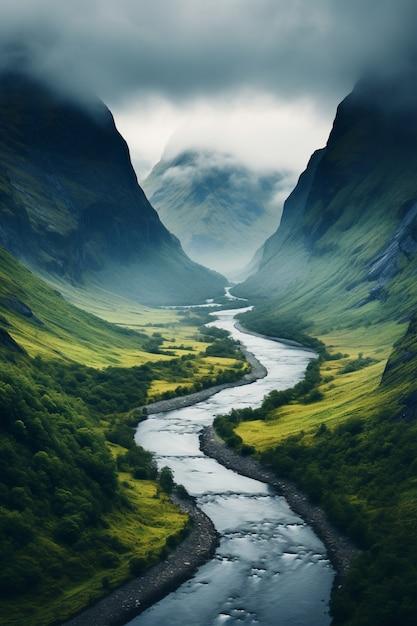Landscape, a term commonly used in various contexts, holds different meanings for different individuals. In the world of art and geography, it refers to the visible features of an area, whether natural or human-made. But what does the term truly entail? How does it connect to ancient literature and Indian history? In this blog post, we’ll explore the multifaceted concept of landscape, shedding light on its significance in different domains.
In the Sangam Age of India, which dates back to the 3rd century BCE to the 3rd century CE, the concept of landscape held great importance. The Sangham era witnessed the emergence of Sangam literature, a collection of Tamil poems that beautifully depicted the landscapes and lives of ancient Tamil Nadu. These literary works portrayed the diverse landforms, themes, and cultural contexts prevalent during that era. Join us on a fascinating journey as we delve into the meaning of landscape in the Sangam Age and its contribution to Indian history and literature.
So, grab a cup of coffee and get ready to explore the enchanting world of landscapes, as we embark on an insightful exploration of this captivating subject. In this blog post, we’ll unearth the hidden gems of Sangam literature, understand the significance of different landforms, and unravel the profound impact of landscape on our lives. Get ready to broaden your horizons and gain a deeper understanding of the dynamic concept of landscape.

What does landscape mean in everyday life
Landscape: it’s a simple word, but it encompasses so much more than just a pretty view. In everyday life, landscape refers to the physical features of an area, including its natural and man-made elements. It’s what you see when you step outside your door and take in your surroundings. And let’s be real, some landscapes can take your breath away, while others… well, let’s just say they’re not going to make it onto any “Top 10 Most Beautiful Landscapes” lists.
The natural wonders of landscapes
Nature has a way of creating breathtaking landscapes that leave us in awe. From majestic mountains to serene lakes, and from lush forests to vast deserts, nature serves up a buffet of stunning scenery. These landscapes not only provide an escape from the hustle and bustle of everyday life but also offer a sense of peace and tranquility. They remind us of the immense beauty that exists in the world and the power of Mother Nature herself.
Man-made landscapes: the good, the bad, and the ugly
As much as we love to praise Mother Nature for her landscape creations, we humans also have our own role to play in shaping the world around us. Man-made landscapes can range from architectural wonders like skyscrapers and bridges to meticulously manicured gardens and parks. Some man-made landscapes blend seamlessly with their surroundings, adding to the natural beauty of an area. Others… well, let’s just say they may leave something to be desired.
Exploring the cultural landscapes
Beyond the physical aspects, landscapes also have cultural, historical, and social significance. Cultural landscapes are the result of human interactions with the environment over time. They can include anything from ancient ruins and historical landmarks to neighborhoods and urban spaces that reflect the local culture and way of life. These landscapes tell stories of our past, present, and future, and they serve as a reminder of the rich tapestry of human experiences.
The ever-changing landscape
One thing we can always count on is that landscapes are never static. They evolve over time, shaped by natural forces and human activities. From the rolling hills of the countryside to the bustling streets of a city, landscapes are alive and constantly changing. They adapt and transform, just like we do. So, the next time you step outside and take in the view, remember that you’re not just looking at a landscape — you’re witnessing a dynamic and ever-evolving piece of the world.
In conclusion, landscapes are not just pretty pictures or picturesque views. They are the physical embodiment of our surroundings, shaped by nature and human intervention. Whether it’s the awe-inspiring wonders of nature or the man-made creations that dot our cities, landscapes define the places we call home. So, take a moment to appreciate the beauty, diversity, and ever-changing nature of the landscapes around you. It’s a reminder that the world is a fascinating and dynamic place.

FAQ: What do you understand by landscape
Welcome to our comprehensive FAQ section on landscapes! In this subsection, we’ll provide answers to frequently asked questions about landscapes – from their meaning and significance to the Sangam age and its literature. So, let’s dive in and explore the fascinating world of landscapes!
What is the meaning of landscape
The term “landscape” refers to the visible features of an area of land, including natural elements such as mountains, rivers, and forests, as well as human-made elements like buildings and roads. It encompasses the overall view of a particular area, including its physical characteristics, vegetation, and the way it is perceived and experienced by individuals.
What is the significance of Sangam
Sangam, which means “confluence” in Tamil, refers to a period in the history of ancient South India. It is known as the Sangam age because it was during this time that literary assemblies, known as Sangams, were held. These assemblies played a vital role in the development of Tamil literature and provided a platform for poets and scholars to showcase their works.
Which city is known as the Sangam city of India
Madurai, a city in the Indian state of Tamil Nadu, is commonly referred to as the “Sangam city of India.” This title is bestowed upon Madurai due to its historical significance as the venue for the ancient Sangam assemblies and as a center for Tamil literature and culture.
What is Palai land
Palai land refers to one of the five main landscapes mentioned in Sangam literature. Palai signifies a barren or desert-like region. It represents areas with dry and arid conditions, characterized by a scarcity of vegetation and limited agricultural potential.
What are the five landscapes
According to the Sangam literature, the five key landscapes, known as Tinai in Tamil, are:
- Kurinji: Mountainous regions with enchanting beauty, often associated with cool temperatures and dense vegetation.
- Mullai: Forested regions abundant in blossoming flowers, creepers, and diverse wildlife.
- Marutham: Agricultural lands or fertile plains known for their lush greenery and cultivation.
- Neythal: Coastal areas with sandy beaches, encompassing marine ecosystems, fishing, and maritime activities.
- Palai: Arid or desert-like regions marked by dryness, scarcity of vegetation, and minimal agricultural prospects.
What are the themes of Mullai
The Mullai landscape in Sangam literature is often associated with pastoral themes and romanticism. It depicts the beauty of nature, the lives of herdsmen, the flowering of love, and the experiences of rural communities. It immerses readers in a world of idyllic landscapes, blossoming flowers, and the enchanting fragrance of love and desire.
What are the important Sangam works
The Sangam age produced several significant literary works, capturing the essence of the Tamil people and their culture. Some notable Sangam works include:
- Tolkappiyam: An ancient Tamil grammar and poetics text.
- Ettuthokai: The Eight Anthologies containing poems covering various themes.
- Pattupattu: A collection of ten idylls portraying different aspects of love and relationships.
- Pathinen Keezhkanakku: Eighteen Lower Collections consisting of diverse poems on love, virtue, and governance.
What is Kurinji land
Kurinji land refers to the mountainous regions depicted in Sangam literature. It represents the beauty of hills and valleys with their unique flora and fauna. Kurinji is particularly known for the blooming of the Kurinji flower, which occurs once every twelve years, creating a mesmerizing purple-blue carpet over the landscapes.
How many landforms are there in the Sangam age
The Sangam age recognizes five primary landforms, or Tinai, as mentioned earlier. These landforms, Kurinji, Mullai, Marutham, Neythal, and Palai, encompass a wide range of geographical features and symbolize the diverse landscapes and ecosystems present during that era.
What is the tinai system
The tinai system is a classification framework used in Sangam literature to associate landscapes with specific emotions, cultural aspects, and agricultural practices. Each tinai represents distinct physical and emotional characteristics, offering a poetic lens through which to explore different aspects of life and nature.
What are the four elements of a landscape
A landscape comprises four essential elements that contribute to its overall character:
- Landforms: The physical features of an area, including mountains, valleys, rivers, and plains.
- Vegetation: The plant life, ranging from forests to grasslands, found within a landscape.
- Water bodies: Such as rivers, lakes, and oceans that shape the environment and support diverse ecosystems.
- Built structures: Man-made elements like buildings, roads, and bridges that coexist with natural features.
Who lives in the mullai land
In Sangam literature, the Mullai land is often associated with pastoral communities and herdsmen. These characters reside amidst the natural splendor of forests, engaging in activities such as tending to livestock, seeking love, and cherishing the serenity of their surroundings.
What is the main importance of the Sangam age
The Sangam age holds great historical significance as it gave birth to a rich literary heritage that continues to shape Tamil culture and identity. It established a foundation for Tamil language, literature, and arts, while also providing insights into the lives, history, and societal norms of ancient South India.
What were the main themes of Sangam literature
Sangam literature encompasses a wide range of themes, including love, war, nature, morality, valor, and governance. It reflects the cultural, social, and emotional aspects of the Tamil people during that period. The verses celebrate heroism, depict vibrant landscapes, and explore profound human emotions, making them timeless pieces of literature.
What is a landscape for kids
Dear young readers, a landscape is like a big, beautiful painting made by nature! Imagine a place where you can see mountains touching the sky, forests filled with colorful flowers, and rivers flowing happily. It’s like stepping into a magical world, where you can explore, play, and use your imagination to create wonderful stories.
What is known as Sangam literature
Sangam literature refers to the collection of poems and writings that emerged during the Sangam age in ancient South India. This remarkable body of work includes poems of various themes, ranging from romantic verses and elegies to descriptions of landscapes and societal norms. It is cherished as a precious treasure that illuminates the history, culture, and emotions of Tamil people from centuries ago.
We hope this FAQ section has provided you with valuable insights into landscapes and their significance within the Sangam age. From the diverse tinai to the enchanting landscapes celebrated in Tamil literature, there’s so much to explore and appreciate. So, go out and embrace the beauty of nature, for landscapes are not only a feast for the eyes but also windows to the soul of a place. Happy exploring!
Note: This content has been generated by an AI language model.
